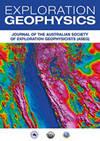Effects of different pore shapes on the pressure and frequency dependence of velocities of oil-saturated tight sandstone
IF 0.8
4区 地球科学
Q4 GEOCHEMISTRY & GEOPHYSICS
引用次数: 1
Abstract
The pressure dependence of elastic parameters of rocks is mainly controlled by the geometry of the pore space. In general, the compliant-stiff pore structure model can be used to reasonably describe this pressure dependence. However, our experiment measurements revealed that for tight sandstone rock with complex pore structures, the contribution of the compressibility of the stiff pores to the elastic modulus is significant. The dual porosity is not sufficient to explain the variation of ultrasonic velocity with pressure. For this reason, we adopted a triple pore structure to divide the rock pore space into equant pores, intermediate pores and compliant pores. Our laboratory measurement and model results show that this pore space division can better describe the pressure dependence of the elastic moduli of rocks. The low-frequency stress–strain measurements show that the fluid-saturated tight sandstone has obvious dispersion in the seismic frequency band, which is primarily attributed to the squirt flow effect. In order to study the pressure and frequency dependence of the elastic moduli of tight sandstone, we retrieved the geometric parameters of the pore structure from the pressure variation of the ultrasonic velocities under dry conditions. Based on this complex pore structure and the extension of the squirt flow model, we constructed an elaborate rock physics model to explain the pressure and frequency dependence of velocity. The model does not require adjustable parameters, and all parameters are measured and calculated by the laboratory, which improves the accuracy of theoretical modelling. The modified squirt flow model can be used to describe dispersion and attenuation in a wide frequency band, and fit well with the velocity measurements in both the low-frequency range and the ultrasonic frequency range under different pressures. Therefore, this rock physics model could be applied in the extraction of pore microstructure and fluid properties provided elastic moduli or velocities can be estimated accurately.不同孔隙形态对含油致密砂岩速度压力和频率依赖性的影响
岩石弹性参数的压力依赖性主要受孔隙空间几何形状的控制。通常,柔性刚性孔隙结构模型可以用来合理地描述这种压力依赖性。然而,我们的实验测量表明,对于具有复杂孔隙结构的致密砂岩,坚硬孔隙的压缩性对弹性模量的贡献是显著的。双重孔隙率不足以解释超声速度随压力的变化。为此,我们采用三孔结构将岩石孔隙空间划分为均匀孔隙、中等孔隙和柔顺孔隙。我们的实验室测量和模型结果表明,这种孔隙空间划分可以更好地描述岩石弹性模量的压力依赖性。低频应力-应变测量表明,流体饱和致密砂岩在地震频带内具有明显的分散性,这主要归因于喷射流效应。为了研究致密砂岩弹性模量的压力和频率依赖性,我们从干燥条件下超声波速度的压力变化中反演了孔隙结构的几何参数。基于这种复杂的孔隙结构和喷射流模型的扩展,我们构建了一个详细的岩石物理模型来解释速度的压力和频率依赖性。该模型不需要可调参数,所有参数都由实验室测量和计算,提高了理论建模的准确性。改进的喷射流模型可用于描述宽频带内的色散和衰减,并与不同压力下低频范围和超声频率范围内的速度测量结果吻合良好。因此,只要能够准确估计弹性模量或速度,该岩石物理模型就可以应用于孔隙微观结构和流体性质的提取。
本文章由计算机程序翻译,如有差异,请以英文原文为准。
求助全文
约1分钟内获得全文
求助全文
来源期刊

Exploration Geophysics
地学-地球化学与地球物理
CiteScore
2.30
自引率
0.00%
发文量
33
审稿时长
>12 weeks
期刊介绍:
Exploration Geophysics is published on behalf of the Australian Society of Exploration Geophysicists (ASEG), Society of Exploration Geophysics of Japan (SEGJ), and Korean Society of Earth and Exploration Geophysicists (KSEG).
The journal presents significant case histories, advances in data interpretation, and theoretical developments resulting from original research in exploration and applied geophysics. Papers that may have implications for field practice in Australia, even if they report work from other continents, will be welcome. ´Exploration and applied geophysics´ will be interpreted broadly by the editors, so that geotechnical and environmental studies are by no means precluded.
Papers are expected to be of a high standard. Exploration Geophysics uses an international pool of reviewers drawn from industry and academic authorities as selected by the editorial panel.
The journal provides a common meeting ground for geophysicists active in either field studies or basic research.
 求助内容:
求助内容: 应助结果提醒方式:
应助结果提醒方式:


